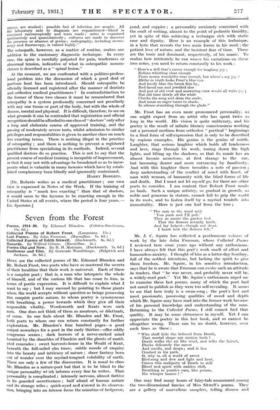Osteopathy and Orthodoxy
Manipulation as a Curative Factor. By Ethel Mellor. (Methuen. 10s. 6d.)
IF the doctors want to lead the people away from osteopathy, they will have to learn how to write at least as well and as convincingly as does the authoress of this book. The champions of orthodoxy would, at any rate, be wise to read this volume, and so inform themselves as to the case for the other side when adequately presented.
The subtleties of subliminal motoneurone excitement and reactions are such that none of us are in a position to deny therapeutic possibilities except on purely empiric grounds ; and the story of the victory of the bonesetters over the orthodox surgeons is, or should be, sufficiently fresh in our memory to remind us that even the most commonsensical may be blind to persistent experience even when events occur under their very eyes.
Whatever may be the explanation, there is no escaping the fact that not infrequently osteopaths have succeeded, and do succeed, in relieving ailments that have resisted the skill and efforts of orthodox physicians and surgeons of reputation and undoubted ability ; nor can we dismiss all of these ailments as imaginary ones. At the same time, this but proves that there is some element of value in the practical technique of osteo- pathy ; it does not prove the theory whereby the osteopaths explain their results.
It is a pure assumption that the predisposing cause of all disease " is some maladjustment or derangement or impair- ment of the structural integrity of the body, which stops or clogs the flow of blood and lymph ; or an interference with the nerve action which controls the flow of the vital fluids." This statement is either so vague and general that it includes all physiological truth without throwing any light on it, or, if a specific meaning can be read into it, it is simply not in accord- ance with fact. It is likely that every functional disorder has its structural coincident ; but, as yet, we have in most cases no means of recognising it. Certainly, there is not always present such crude physical displacement, whether of bone, muscle or ligament, as can be rectified by manual adjustment. Many of the " cures " honestly claimed by the osteopaths are attribut- able—as are most of the cures attributed to drugs—to purely psychic causes ; and Miss Mellor is on safe dialectic ground when she sets up peculiarly osteopathic methods of therapy in rivalry to the prescriptions of the physicians. Other of the
cures are brought about by the breaking down of minor adhesions in the structures around the vertebral joints—
adhesions which are probably much more common than is usually suspected. But, if Miss Mellor is to be taken as an authoritative exponent, there is little difference between this cult and orthodox doctrine and practice, in all those parts of the medical and surgical art which alone competent modern surgeons and physicians would think it worth while arguing about.
" Diagnosis is the most difficult of all the functions the doctor is called upon to perform. Without diagnosis, treat- ment may be ineffectual, and valuable time and perhaps a life may be lost. The doctor must visualize the unseen patho- logical processes of disease ; he must seek in the laboratory the confirmation of his visualization." This is very different from the slap-dash one-cause, one-cure method of the earlier apostles. Nor are the methods of osteopathic diagnosis, as Miss Mellor describes them, very different from those of orthodoxy.
" The physical appearance of • all parts of the body, the tem- perature, pulse, blood-pressure, heart, lungs, abdominal and pelvic organs, are studied ; possible foci of infection are sought. All the laboratory aids to diagnosis are requisitioned—blood is examined microscopically and tests made ; urine is examined qualitatively and quantitatively ; cultures are made to discover the presence or absence of germs ; radiography, including stereo- scopy and fluoroscopy; is valued highly."
The osteopath, however, as a matter of routine, makes one addition to the customary diagnostic technique. In every case, the spine is carefully palpated for pain, tenderness or abnormal tension, indicative of what in osteopathic nomen- clature is described as a " spinal lesion."
At the moment, we are confronted with a politico-profess- ional problem into the discussion of which a good deal of partisan heat has been introduced. Should osteopaths be officially licensed and registered after the manner of dentists and orthodox medical practitioners ? In contradistinction to the former of these two classes it must be remembered that osteopathy is a system professedly concerned not peculiarly with any one tissue or part of the body, but with the whole of disease, mental and physical. It is difficult, therefore, to see on what ground.s it can be contended that registration and official recognition should be afforded to one class of " doctors" only after a long and elaborate course of approved training, and the passing of moderately severe tests, whilst admission to similar privileges and responsibilities is given to another class on much less exacting terms. There is nothing illegal in the practice of osteopathy ; and there is nothing to prevent a registered practitioner from specialising in its methods. Indeed, several qualified doctors do so practice. This is not to say that the present course of medical training is incapable of improvement, or that it may not with advantage be broadened so as to incor- porate what is valuable in many heresies which have by estab- lished complacency been blindly and ignorantly contemned.
HARRY ROBERTS.
[Dr. Roberts writes as a medical practitioner ; our own view is expressed in Notes of the Week. If the training of osteopathy is " much less exacting " than that of doctors, it would seem to the layman to be exacting enough in the United States at all events, where the period is four years.— En. Spectator.]












































 Previous page
Previous page